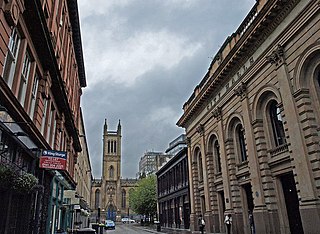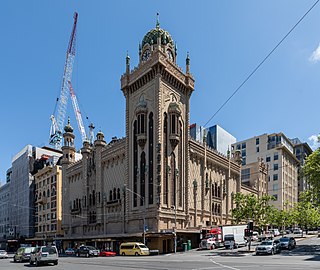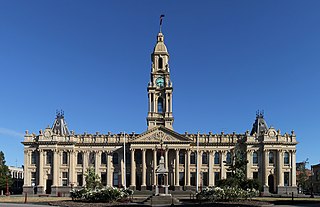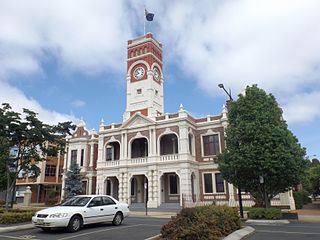
The Royal Festival Hall is a 2,700-seat concert, dance and talks venue within Southbank Centre in London, England. It is situated on the South Bank of the River Thames, not far from Hungerford Bridge, in the London Borough of Lambeth. It is a Grade I listed building, the first post-war building to become so protected. The London Philharmonic Orchestra, the Philharmonia Orchestra, the Orchestra of the Age of Enlightenment, the London Sinfonietta, Chineke! and Aurora are resident orchestras at Southbank Centre.

David Geffen Hall is a concert hall in New York City's Lincoln Center for the Performing Arts complex on Manhattan's Upper West Side. The 2,200-seat auditorium opened in 1962, and is the home of the New York Philharmonic.
Singapore has a diverse music culture that ranges from rock and pop to folk and classical. Its various communities have their own distinct musical traditions: the Chinese form the largest ethnic group in Singapore, with Malays, Indians as well as a lesser number of other peoples of different ethnicities including Eurasians. The different people with their traditional forms of music, the various modern musical styles, and the fusion of different forms account for the musical diversity in the country.

Massey Hall is a performing arts theatre in Toronto, Ontario, Canada. Opened in 1894, it is known for its outstanding acoustics and was the long-time hall of the Toronto Symphony Orchestra. An intimate theatre, it was originally designed to seat 3,500 patrons, but after extensive renovations in the 1940s, it now seats only up to 2,765. It has an extensive history of concerts by artists of many musical genres which continues today.

The Singapore Symphony Orchestra (SSO) is a symphony orchestra based in Singapore. It is Singapore's flagship orchestra. Its principal concert venue is the Esplanade – Theatres on the Bay. The orchestra also gives concerts at the Victoria Theatre and Concert Hall, and performs over 60 concerts per year. The orchestra was first established In 1978 with Choo Hoey its resident director. The orchestra's music director from 1997 to 2019 was Shui Lan, and Hans Graf its Chief Conductor from 2020 and Music Director from 2022. The SSO is part of the Singapore Symphony Group, which also manages the Singapore Symphony Choruses, the Singapore National Youth Orchestra (SNYO), the VCHpresents chamber music series, the Singapore International Piano Festival and the biennial National Piano and Violin Competition. It achieved third place in 2021 for Gramophone's Orchestra of the Year award, and made the list of the BBC Music Magazine's Top 21 Best Orchestras in the World in 2022.

The Arts House is a multi-disciplinary arts venue in Singapore. The venue plays host to art exhibitions and concerts. Built in 1827, the Old Parliament House is the oldest government building and perhaps the oldest surviving building in Singapore. The building was home to the Parliament of Singapore from 1965 to 1999, when it moved to an adjacent new building.

Glasgow's City Halls and Old Fruitmarket is a concert hall and former market located on Candleriggs, in the Merchant City, Glasgow, Scotland.

The Forum Theatre is a historic theatre and former cinema now used as a live music and event venue located on the corner of Flinders Street and Russell Street in Melbourne, Australia.

The Municipal Group of Springfield, Massachusetts, United States is a collection of three prominent municipal buildings in the city's Metro Center district. Consisting of a concert hall, City Hall, and a 300-foot-tall (91 m) clocktower, the Group is a center of government and culture in the city.

South Melbourne Town Hall is a landmark civic building located on Bank Street in South Melbourne, a suburb of Melbourne, Victoria, Australia. It is listed on the Victorian Heritage Register as of state heritage significance to Victoria.

Heinz Hall is a performing arts center and concert hall located at 600 Penn Avenue in the Cultural District of Pittsburgh, Pennsylvania. Home to the Pittsburgh Symphony Orchestra (PSO) and the Pittsburgh Youth Symphony Orchestra, the 2,676 seat hall presents about 200 performances each year. Originally built in 1927 as Loew's Penn Theatre, the former movie palace was renovated and reopened as Heinz Hall in 1971.

The Brighton Dome is an arts venue in Brighton, England, that contains the Concert Hall, the Corn Exchange and the Studio Theatre. All three venues are linked to the rest of the Royal Pavilion Estate by a tunnel to the Royal Pavilion in Pavilion Gardens and through shared corridors to Brighton Museum. The Brighton Dome is a Grade I listed building.

An atmospheric theatre is a type of movie palace design which was popular in the late 1920s. Atmospheric theatres were designed and decorated to evoke the feeling of a particular time and place for patrons, through the use of projectors, architectural elements and ornamentation that evoked a sense of being outdoors. This was intended to make the patron a more active participant in the setting.
Swan & Maclaren Architects is a Singaporean architectural and industrial design firm. One of the oldest architectural firms in the country, it was formerly known as Swan & Maclaren and Swan & Lermit, and was one of the most prominent architectural firms in Singapore when it was a crown colony during the early 20th century. The firm has designed numerous iconic heritage buildings in Singapore as well as Malaysia.

Toowoomba City Hall is a heritage-listed town hall at 541 Ruthven Street, Toowoomba, Toowoomba Region, Queensland, Australia. It was designed by Willoughby Powell and built in 1900 by Alexander Mayne. It is also known as Toowoomba Town Hall. It was added to the Queensland Heritage Register on 21 October 1992.

Yeadon Town Hall is a municipal building in Yeadon, West Yorkshire, England. It is Grade II listed.
The Queen Victoria Memorial in George Town, Penang is a monument to Queen Victoria, begun after her death, located at the Penang Chinese Recreation Club. Penang's Victoria Memorial takes the form of a large piece of land known as "Victoria Green," and a statue at the edge of Victoria Green at the junction of Burmah Road and Pangkor Road, the establishment of each being years apart from the other. The grounds were purchased and set up in 1903 and the statue unveiled in 1930, nearly three decades later.
Regent Alfred John Bidwell, or R. A. J. Bidwell, was an English-born architect noted for his colonial era buildings in Singapore. His best-known works include the Raffles Hotel and the Victoria Theatre and Concert Hall in Singapore, and Sultan Abdul Samad Building in Kuala Lumpur.

Capitol Theatre, briefly Kyo-Ei Gekijo, is a historic cinema and theatre located in Singapore. It was adjoined to four-storey building known as the Capitol Building. The Capitol Theatre was considered one of Singapore's finest theatres in the 1930s during that time.

Shaw Tower, also sometimes referred to as Shaw Towers, is a defunct high-rise commercial building located on Beach Road in Singapore. At the time of its completion in 1975, the tower housed the largest cinema in Singapore.

























